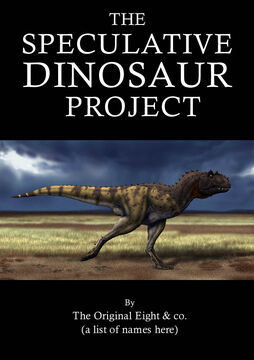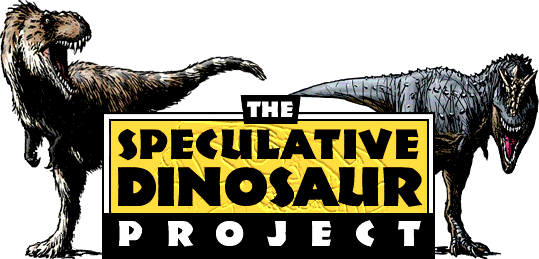Most of the following content is outdated, though some of the information is mostly up to date. See more recent entries, essays, discussions, and suggestions in the Yahoo Group. Despite the fact that the Yahoo Group is unfortunately not running anymore, A revival of the project has taken place on this page. However, a new website for the project will be established sometime in the near future based on what was published and some stuff discussed in the yahoo group that never made the final project.
This is the current Spec page with Yahoo Groups, unfortunately, being shut down back in December 2019. Fortunately, most if not all of the content was saved before the shutdown.
Copyright © 2001 – 2005 Daniel Bensen and David Marjanović Graphic design and illustrations by Tiina Aumala, 2003 – 2005
Foreword
"Once one dismisses The rest of all possible worlds, One finds that this is The best of all possible worlds." – Leonard Bernstein, Candide
65.5 million years ago the Chicxulub bolide, a mountain of rock some 12 km across, struck the Earth. The asteroid's origins are unknown, but fate had tied the destiny of our home, Earth, to that of the rock. When the rock struck, our Earth was changed forever.
The impact left several legacies: the enormous Chicxulub crater just off the coast of Mexico's Yucatán Peninsula, a layer of iridium-rich clay that forms the boundary between Mesozoic and Cenozoic in the Earth's rock strata, and the extinction of some 75 % of all fossilisable species.

Planned Book Cover
In short, the impact marked the end of the Mesozoic with the great Cretaceous-Palaeogene (or K-Pg) mass extinction event. It ushered in a new era in the evolution of vertebrate life on Earth. Many groups of organisms, for example the ammonoid cephalopods, the bennettitalean plants, and the enantiornithean birds along with most other dinosaurs, were completely obliterated by this, the greatest extinction in almost 200 million years. The mammals, those furry, lactating therapsids, the creatures that had lost the original battle for ascendancy after the last great extinction to the dinosaurs, suddenly found themselves in an empty world almost devoid of competition.
In the wake of the K-Pg extinction, mammals exploded into dazzling array of giant forms. Within 10 million years, almost all of the modern groups of mammals (and then some) had already appeared. The mammals conquered the land, the water, and even the air (although the last remaining dinosaurs, the neornithean birds, are unquestionably dominant at least in the air – they actually contain about half of all amniote species). Today, furry creatures occupy every continent and, only 65 million years after the asteroid struck, have produced organisms of astonishing variety, from blue whales to shrews, from hyenas to humans, from elephants to bats. The (non-neornithean) dinosaurs, once the largest land animals on the planet, have been reduced to mere stone and imagination.
But what if none of this history were true?
What if the rock had missed?
One can speculate.
The World
Strange Geography
The Specworld, is, to put the matter simply, a parallel Earth.
For the most part, Spec is exactly like our home timeline (also called Home-Earth). Both planets orbit their middle-aged, G-class stars at the distance of a single astronomical unit, possess continents and oceans in near-identical configuration (differences include the absence of man-made geography), and a single, large moon. Both planets are clothed in a layer of atmosphere (mostly nitrogen and oxygen), and, although our home Earth is rather warmer (and still warming) and more generally chaotic in climate, both have similar global weather. In short, Home-Earth and Spec are virtually the same planet, and in fact were the same planet until quite recently in their geologic histories.
Given the inexactitude of the fossil record, it is difficult to determine exactly when Spec diverged from our Home-Earth. However, we can be certain of one thing: no asteroid hit the planet 65 million years ago. There is no crater under the coast of Spec's Yucatán, nor the shocked quartz, micro-diamonds, soot, or clay layer (rich in iridium, osmium, gold and other rare metals) spawned by the impact that in our home timeline ended the Cretaceous Period and ushered in the Palaeogene Period. As far as anyone can tell, the Chicxulub impact, and the subsequent rise of the mammals throughout the Cenozoic, have failed entirely to occur.
While on Earth, the Palaeogene was marked by the ascendance of mammals, on the Specworld, nothing seems to have happened to the dinosaurs. The mammals did not spread across the land and sea as the largest animals in existence; whole swaths of Mammalia, including dolphins, horses, and humans, have failed entirely to evolve. Instead, the dinosaurs rule, and have ruled for some time.
The story of how mankind first came to Spec is an interesting one, but the exact mechanics of the process are outside the scope of this publication and will be addressed elsewhere. Suffice to say that, now that we have lived on Spec for some time, have seen the sights and arranged our work into some sort of order, the explorers of Spec now feel the time is appropriate to introduce the public to our new world.
The Specworld bestiary is, in some cases, wildly different from that of Home-Earth; the dinosaurs are by far not the only difference – even the bacteria are not all the same. However, both worlds respond to the same laws of nature. The study of one will, we are sure, illuminate the other.

